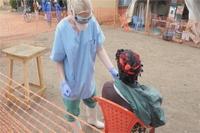-
Using artificial intelligence to forecast future infectious disease outbreaks
Most emerging infectious diseases are transmitted from animals to humans, with more than a billion people suffering annually. Safeguarding public health requires effective surveillance tools. Researchers used machine learning – a form of artificial intelligence — to pinpoint rodent species that harbor diseases and geographic hotspots vulnerable to new parasites and pathogens.
-
-
Antibiotic resistant typhoid detected in countries around the world
There is an urgent need to develop global surveillance against the threat to public health caused by antimicrobial resistant pathogens, which can cause serious and untreatable infections in humans. Typhoid is a key example of this, with multidrug resistant strains of the bacterium Salmonella Typhi becoming common in many developing countries. A landmark genomic study, with contributors from over two-dozen countries, shows the current problem of antibiotic resistant typhoid is driven by a single clade, family of bacteria, called H58 that has now spread globally.
-
-
In Kenya, human health and livestock health are linked
It is that 300 million people living in sub-Saharan Africa depend on their livestock as a main source of livelihood and nutrition. If a farmer’s goats, cattle, or sheep are sick in Kenya, how is the health of the farmer? Though researchers have long suspected a link between the health of farmers and their families in sub-Saharan Africa and the health of their livestock, a team of veterinary and economic scientists has quantified the relationship for the first time in a study.
-
-
Halting response to the 4 Ebola cases in U.S. valuable in preparations for bioterror attacks
The Ebola outbreak in West Africa has killed at least 10,000 people to date. There were only four Ebola diagnoses in the United States, one of which resulted in a death, but many public health officials say the U.S. response to in-country cases is a lesson on how government can prepare for a bioterror attack. Experts warn, though, thatthe United States is only prepared to confront a fraction of the fifteen potential biological agents that could be released in an attack, adding that many U.S. cities would be left scrambling to respond.
-
-
Seattle infectious disease research center hosts “Rally for Global Health”
Fourteen million people die from infectious diseases around the world every year. The Seattle, Washington-based Center for Infectious Disease Research (formerly Seattle BioMed) hosted the “Rally for Global Health” last week to raise awareness for the Washington state global health and life-sciences industries and formally launch a petition urging congress to increase funding for the National Institutes of Health. During the event, the Center for Infectious Disease Research, which is the largest independent nonprofit in the world focused solely on infectious disease research, officially announced the organization has changed its name and is no longer Seattle BioMed.
-
-
Disease can be monitored, predicted by analyzing views of Wikipedia articles
Scientists can now monitor and forecast diseases around the globe more effectively by analyzing views of Wikipedia articles. Researchers were able successfully to monitor influenza in the United States, Poland, Japan and Thailand, dengue fever in Brazil and Thailand, and tuberculosis in China and Thailand. They were also able to forecast all but one of these, tuberculosis in China, at least twenty-eight days in advance.
-
-
The growing economic cost of infectious diseases
Emerging pandemic disease outbreaks such as Ebola increasingly threaten global public health and world economies, scientists say. We can expect five new such diseases each year, into the future. We should also expect them to spread. The tropical disease dengue fever, for example, has made its way to Florida and Texas, seemingly to stay. Five new such diseases expected each year; strategies to reduce climate change adaptable to infectious diseases. Economists, disease ecologists, and others collaborated on an in-depth economic analysis of strategies to address pandemic threats in a proactive way — rather than a reactive response to a crisis.
-
-
Rate of infection in West Africa has begun to slow down

Public health officials monitoring the Ebola epidemic in West Africa say the outbreak may have reached a turning point in which transmissions may have begun to slow down. Dr. Jeremy Farrar, director of the Wellcome Trust, the organization funding a series of fast-tracked trials of Ebola vaccines and drugs, says that although the virus will continue to infect people in the months ahead, “it is finally becoming possible to see some light.”
-
-
Infection outbreaks, unique diseases on the increase since 1980
Ebola has a lot of company. In a novel database now made publicly available, researchers found that since 1980 the world has seen an increasing number of infectious disease outbreaks from an increasing number of sources. The good news, however, is that they are affecting a shrinking proportion of the world population. The number of infectious disease outbreaks and the number of unique illnesses causing them appear to be increasing around the globe, with more than 12,000 outbreaks affecting forty-four million people worldwide over the last thirty-three years.
-
-
Lack of federal authority makes fashioning coherent national Ebola policy difficult

Earlier this week, the Centers for Disease Control and Prevention(CDC) issued new guidelines on how states should deal with travelers from Ebola-stricken regions, but a lack of federal authority to mandate such guidelines has led to conflicting strategies, varying from state to state, which includes mandatory at-home quarantine for some travelers. Under current U.S. law, the states have the authority to issue quarantine or isolation policies, and they also control the enforcement of these policies within their territories.
-
-
Infection projections: how the spread of Ebola is calculated
Ebola is an example of an emerging infectious disease (EID): one that has newly appeared in a population or has undergone a rapid increase in incidence. Bioinformatics plays a key role in detecting, monitoring and responding to EIDs. In the case of Ebola, the bioinformatics community has responded rapidly. For example, the current outbreak of Ebola in Sierra Leone was first detected in May, but by September a study reported sequencing 99 Ebola virus genomes from 78 patients diagnosed with the disease between late May and mid-June. Bioinformaticians have been developing and refining algorithms for sequence assembly since the late 1980s, and are constantly adapting them so they can handle new sequencing technologies and ever-larger scales of assembly. Bioinformatics is, and will continue to be, a core component of the international response to Ebola and other EIDs, and patients, medical staff and those close to them need all the help they can get.
-
-
Genes of Gypsies show traces of convergent evolution in response to Black Death
The Black Death once exterminated up to 30-50 percent of Europeans. Researchers have identified immune system genes in Europeans and Gypsies that likely underwent convergent evolution during Europe’s deadly epidemics. Immune system genes evolve under the influence of infectious diseases, but few studies have attempted genome-wide assessments of infection-driven evolution.
-
-
Superbugs were found breeding, spreading in sewage plants
Antibiotic-resistant bacteria have been raising alarms for years, particularly in hospital environments where public health officials fear they can be transferred from patient to patient and are very difficult to treat. Bacteria harboring the encoding gene that makes them resistant have been found on every continent except for Antarctica. Tests at two wastewater treatment plants in northern China revealed antibiotic-resistant bacteria —“superbugs” carrying New Delhi Metallo-beta-lactamase (NDM-1), a multidrug-resistant gene first identified in India in 2010 — were not only escaping purification but also breeding and spreading their dangerous cargo. NDM-1 is able to make such common bacteria as E. coli, salmonella, and K. pneumonias resistant to even the strongest available antibiotics.
-
-
New test for detecting newly emerging strains of drug-resistant superbug
Molecular assays for MRSA are used in active surveillance programs to identify colonized patients rapidly. Active surveillance is a proven strategy to reduce transmission in healthcare settings and it helps prevent infection in vulnerable patients. BD Diagnostics has received FDA clearance to market the BD MAX MRSA XT Assay for use on the BD MAX System. This is the second assay from BD Diagnostics capable of detecting newly emerging MRSA strains with the novel mecC gene.
-
-
1950s pandemic flu virus still a health threat today, particularly to those under 50

Scientists have evidence that descendants of the H2N2 avian influenza A virus that killed millions worldwide in the 1950s still pose a threat to human health, particularly to those under 50. The study included twenty-two H2N2 avian viruses collected from domestic poultry and wild aquatic birds between 1961 and 2008, making it the most comprehensive analysis yet of avian H2N2 viruses.
-
- All
- Regional
- Water
- Biometrics
- Borders/Immig
- Business
- Cybersecurity
- Detection
- Disasters
- Government
- Infrastructure
- International
- Public health
- Public Safety
- Communication interoperabillity
- Emergency services
- Emergency medical services
- Fire
- First response
- IEDs
- Law Enforcement
- Law Enforcement Technology
- Military technology
- Nonlethal weapons
- Nuclear weapons
- Personal protection equipment
- Police
- Notification /alert systems
- Situational awareness
- Weapons systems
- Sci-Tech
- Sector Reports
- Surveillance
- Transportation
Advertising & Marketing: advertise@newswirepubs.com
Editorial: editor@newswirepubs.com
General: info@newswirepubs.com
2010-2011 © News Wire Publications, LLC News Wire Publications, LLC
220 Old Country Road | Suite 200 | Mineola | New York | 11501
Permissions and Policies
Editorial: editor@newswirepubs.com
General: info@newswirepubs.com
2010-2011 © News Wire Publications, LLC News Wire Publications, LLC
220 Old Country Road | Suite 200 | Mineola | New York | 11501
Permissions and Policies
